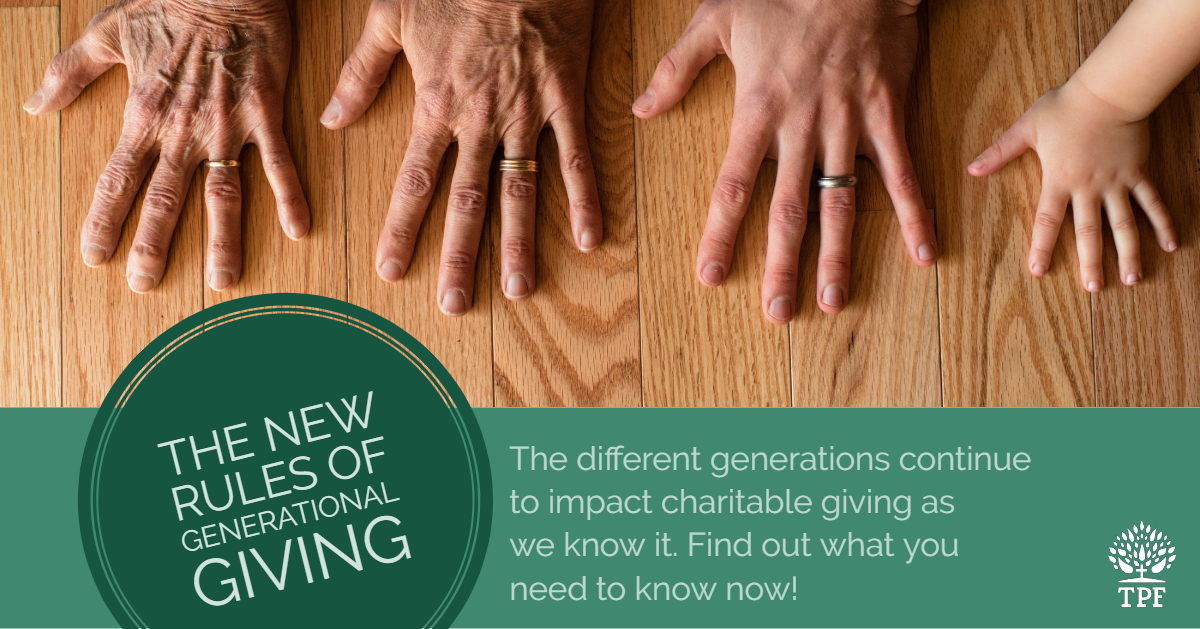The New Rules of Generational Giving

By Jake Wilson, TPF Relationship Manager
Like everything else in this world, charitable giving continues to change. What’s causing the continued evolution? That would be the difference in the way different generations give to their churches and favorite charities.
As you’re most likely aware, by most metrics, our older generations are the biggest donors. They’ve worked the longest, saved the most, are entering estate planning phases, and are thinking about the kind of legacy they want to leave. These generations are more likely to be “first fruit givers” and feel a duty to give – typically to institutions. Their parents taught them that while money can bring personal security, there should also be a commitment to give so that they support and strengthen society. Their high level of institutional trust may translate into consistent annual gifts to your charitable organization or pledges/tithes to your church. When communicating with older generations, it is important to create a conversation around how they wish to be remembered and the legacy they wish to leave behind someday.
Younger generations are indeed eager to support your organization, but not in the same way as their parents or grandparents. They are less attached to religious institutions than older generations, and they don’t just give out of a sense of duty or obligation. Younger generations often give in many smaller spurts to various causes across all sorts of charitable channels (e.g., local nonprofits, charitable crowdfunding campaigns on GoFundMe, volunteer work, etc.). At the end of the day, they are largely motivated by the feeling that they are making a direct and tangible difference towards a cause or an immediate improvement in someone’s life.
Warranted or not, younger people may have the preconception that giving to an institution will result in the diluted benefit of their gift or perhaps even the misdirection of their generosity completely. Providing full transparency and telling stories of great mission work will show young givers that your organization is genuinely an efficient steward of their gift and a worthy avenue between donors’ resources and the greater impact for good. For them, the why is more important than the organization or institution.
As you communicate with both generations, be sure to implement the following key considerations:
- Remember that younger people are often seeking a faith-based community where they can grow spiritually and build relationships
- Explain how your organization spends and invests money in mission
- Create meaningful connections with people of all generations by sharing stories to which they can easily relate
- Reinterpret stewardship: 1) holistically 2) about the individual’s need to give, NOT your organization’s need to receive, 3) leading to spiritual health and growth
- Encourage mission experience
- Receive gifts electronically
- Provide quality programming
- Communicate consistently via social media
- Offer education via financial planning and management courses
For more insight on generational generosity, please join me for our upcoming free webinar on February 25th, “GENERATIONAL GENEROSITY: Making the Greatest Impact for Good.” CLICK HERE TO REGISTER TODAY!
Additionally, TPF provides print resources at no cost to you that have been specifically designed to support the growth of generosity. CLICK HERE to order now! I hope you’ll take advantage of these valuable resources.
Connect with TPF
Our experienced team is ready to help build a financial strategy tailored to your needs.